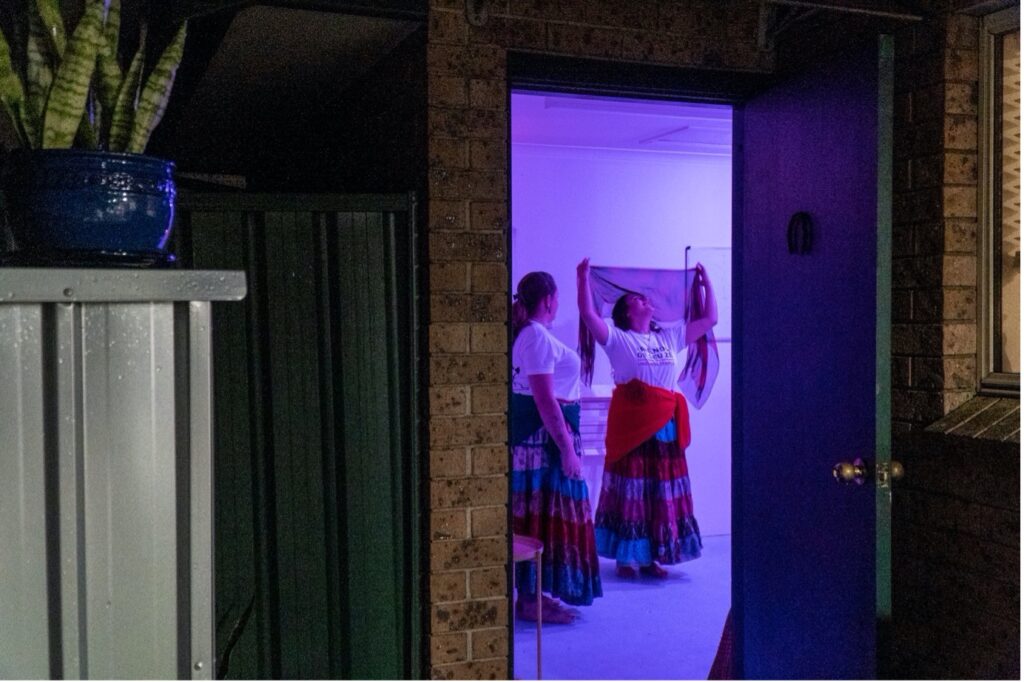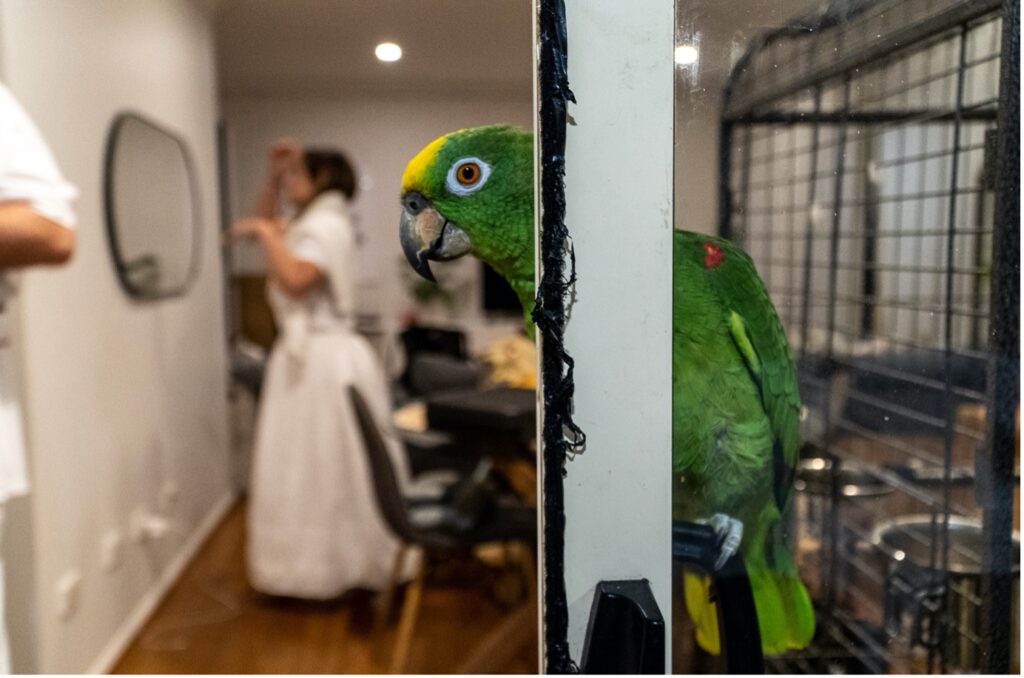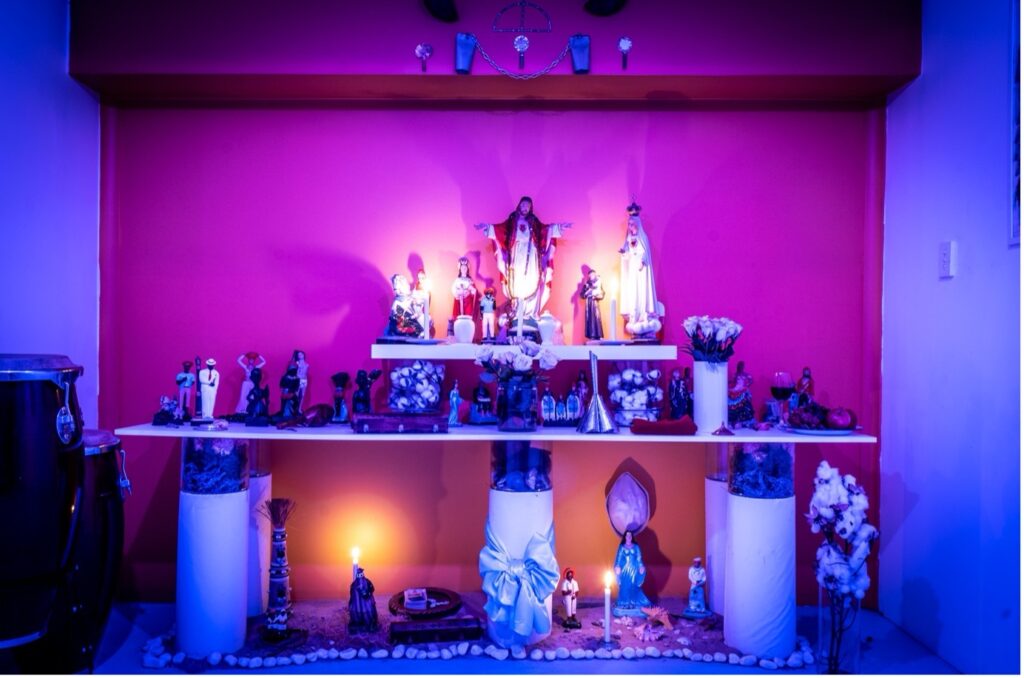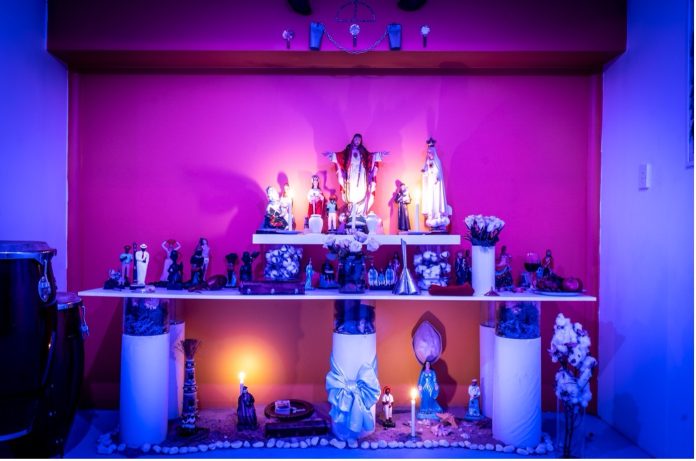A growing Brazilian population brings with it a religion that reveals much about the history of the country and its people
I am not looking forward to taking my shoes off, but I know I have to. I am sitting in a dark garden, on the back row of neatly placed white plastic chairs, shivering. It is the middle of Autumn in Sydney, and the nights have just started to get cold. Although there are nine other people on the chairs with me, no one speaks. The musical drone of crickets is punctuated by the odd shout, swear word or obnoxious laugh floating out from the tin shed opposite us – glowing from the red light within.
I am at the ‘Terreiro Amigos do Seu Zé’, an unassuming terrace house in Kirrawee, Sydney, where the Afro-Brazilian religion of Umbanda is practiced. I watch each person before me called into the shed one by one. One girl comes out crying. She pours herself a glass of water from the flask that’s provided, then leaves. The plastic chairs begin to empty. When the person next to me has been called, I know by watching those before me, that I must now remove my shoes. I do so reluctantly. Rubbing my feet against each other for warmth, I wait silently for my turn.
Brazilian immigration has a history in Australia that dates back to the 19th century, when small numbers would migrate via English ships stopping at Rio de Janeiro on route to Australia. The numbers began to grow from the late 1960s, with the Australian government’s Assisted Migration program and later in the 1980s when many were relocated towards the end of the brutal military dictatorship in Brazil.
The numbers remained relatively small until the last two decades, with census information recording a quadrupling in the Brazil-born population from around 7000 in 2006 to around 28,000 in 2016. This recent wave of migration is mostly driven by young middle-class adults, looking to learn English, or build a life in a safer and more stable country. As their numbers grow, so do aspects of their culture in the lives of many Australians – a Samba night here, an Acaí shop there, a Brazilian Jiu Jitsu club down the street. But it is the appearance of a lesser-known aspect of their culture, the Umbanda religion, in three of the country’s capital cities, that suggests the roots of Brazilian immigration are deepening. Aside from being a fascinating religion, exploring Umbanda gives us a window into unfamiliar aspects of the deep and varied history of Brazil.
One that had a lasting impact on the social and cultural structure of the country is slavery. Beginning midway through the 16th century, Brazil imported more enslaved Africans than any other country, which amounted to roughly 40 per cent of the total number stolen from Africa and taken to the Americas – around 10 times that of the United States. Enslaved Africans were pivotal in the growth of the Brazilian economy. They provided the labour force behind all of Brazil’s main exports at the time, from sugar in the 1600s to diamonds and gold in the 1700s and the rise of coffee in the 1830s. Slavery had such wide support among the population of Brazil that it wasn’t abolished until 1888, 20 years later than the US, and only after significant international pressure.

As a result of the huge numbers of enslaved Africans brought to Brazil’s shores, more than 50 per cent of Brazil’s population identify as having African heritage, the largest black population outside Africa. Following abolition there was a movement among elites in the country to promote an idea of ‘Racial Democracy’, which gave a false sense of harmonious living between white, Indigenous, and black Brazilians. This paved the way for a denial of racism among many Brazilians, even though the black population did, and still does, comprise the poorest and most disadvantaged sector of Brazilian society. Although this viewpoint lost prominence over time, there has been a resurgence of racism denial with Brazil’s current far-right President, Jair Bolsonaro, who has openly defended Brazil’s slave trade.
Slaves had Catholicism forced upon them, but many managed to secretly practice their own religions, hiding their numerous Gods (the Orixás) behind the many Catholic saints. This eventually grew into the most widely practiced Afro-Brazilian religion in Brazil today – Candomblé. It was violently persecuted by white elites until the 1970s and still suffers from prejudice today. To many white Brazilians, Candomblé was symbolic of all that is un-western, un-civilised and undeveloped.
Umbanda, emerging as a distinctly Brazilian religion in Rio de Janeiro in the early 20th century, is widely seen as a mixture of Candomblé with Spiritism – a spirit-invoking religion that was popular with middle class whites in Brazil. The precise origins of Umbanda are unknown and disputed, but many believe it began when a white middle class teenager, Zélio Fernandino de Moraes, attended a Spiritism séance in Niteroi in Rio de Janeiro and embodied a spirit of an Indigenous Indian and an old African slave. He is believed to have subsequently created Umbanda as a form of Spiritism that utilised rituals and deities from Candomblé. Others believe it had earlier roots that have a stronger connection with older Afro-Brazilian traditions and the introduction of Spiritism came later. Either way, taking key elements from both religions, Umbanda reveres the Orixás, but takes from Spiritism the devotee’s embodiment of a range of spirits.
A young woman wearing a long red skirt emerges from the shed. “Next?”she says. I follow her barefoot into the shed. The red light I could see from outside fills the room, flickering candlelight reflecting on the faces of five or six people standing against the walls. At the back of the space is an altar decorated with statues of Catholic saints alongside African deities, with offerings of fruit, alcohol and incense. A man sits in front of the alter, glowing in the candlelight, smoking a cigar and wearing a tall, black hat. He is arguing with a woman at the side of the room. I hesitate, not knowing what to do. “You can sit down, daughter,” he says to me in Portuguese. As I do, he asks if I drink whisky. I answer yes. He offers me a sip of his and releases a cloud of cigar smoke into the space between us as I drink. I am meeting the spirit of Exú.

I have met this man before, when I first arrived at the Terreiro, but he was very different. He was Filipi Goes Souza, a 32-year-old from São Paulo, who has been practicing both Candomblé and Umbanda for most of his life, and was the first to open an Umbanda centre in Sydney in 2016. He began in the living room of his small apartment, but as his following grew, he upgraded to a terrace house with a garden and a shed. The shed is renovated to serve as an extra room, where the Umbanda rituals take place. Every Thursday evening, Filipi, now known as the ‘Pãe de Santo’ (father of the saints), and his ‘Filhos de casa’ (children of the house) host a ‘Gira’. This is the time when members of the public come to receive advice and healing from whichever spirit graces the Terreiro that night.
Filipi explains that the spirits come to help us improve ourselves and our lives, but they do so by forcing us to face that which we most fear about ourselves. “The spirits are gonna give you what you need,” he says, “doesn’t matter how painful it’s going to be for you, but they’re gonna give you what you need.”
Exús is one of the most revered spirits in Umbanda. He is sometimes known as the devil, always as the trickster and the divine messenger. Experienced mediums will typically embody numerous different spirits at different times, and the Exú of each medium will be different.
“Are you happy?” Filipi’s Exú asks me after I hand back his glass of whisky. I hesitate. “Sometimes,” I answer feebly. “Don’t give me that piece of shit answer!” he shouts, moving his face closer to mine. “Are you f…ing happy?”
I feel exposed. I wasn’t expecting to be so confronted, but the thing about Exús is that it doesn’t hold back.
The next week I return to talk to Filipi some more. This time he is dressed in white in preparation to receive the ‘Bahiano’ spirit, representative of the people of the State of Bahia in Brazil. This is the birthplace of Candomblé. A green parrot mutters behind him as he talks.
“Imagine how many things we hide from ourselves,” he explains. “They bring them in your face, like that! It’s time for you to face all this fear and move on. That is the first part inside the Terreiro.”

The spirits of Umbanda represent different archetypes of Brazilian society and the number and type vary, depending on the centre. As well as the ‘Exús’ and ‘Bahianos’, other common spirits are: the ‘Caboclos’, representing Indigenous Brazilian Indians; ‘Pretos Velhos’ (translated literally as ‘Old Blacks’), which represent old slaves; ‘Ciganos’, who are gypsy spirits; and ‘Pomba Giras’, women with foul mouths and loose morals that represent female strength and sexuality. Each spirit belongs to a lineage that traces back to one of Candomblé’s Orixás, but in Umbanda the Orixás themselves are not usually embodied by the mediums, but paid respect to in different ways.
Scholars argue that the variation in type and representation of each spirit is a product of the social construct in which the Umbanda centre exists. Centres range from being heavily influenced by African traditions and to the untrained eye, almost indistinguishable from Candomblé, to what is sometimes known as ‘White Umbanda’. These centres actively distance themselves from and are often disdainful of any African elements, echoing the strong historical racial hierarchy in Brazil that continues to this day. Filipi’s Terreiro falls somewhere in the middle.
The ‘filhos de casa’ attend weekly ‘development’ sessions, where they learn to incorporate their own spirits. “Incorporation is different from possession,” says Will Johnston, the only Australian member of Filipi’s Terreiro. “The entity will start talking to you with words and impressions… then it’s not so much taking over, but it’s… quite an intense cooperation.”
Will explains that in his first development session, which he now does every week, he incorporated a ‘Pomba Gira’ spirit, then promptly passed out and couldn’t remember a thing. Other members told him he had been extremely energetic and ended up jumping into the splits on the floor, something he had never done in his life. Will tells me his life has changed for the better since practicing Umbanda. “Everyone will tell you, I’m a completely different person. I’ve let go of all the toxic people pleasing…that’s all gone now.”
Watching the ‘filhos de casa’ working with their spirits, I feel that perhaps incorporating these various archetypes and personalities gives them permission to embody parts of themselves they are afraid to express in their daily lives. Sceptics claim the invocation of spirits and messages from beyond is, when it’s not outright fraud, nothing more than expressing our suppressed or subconscious impulses or thoughts. In that sense, forms of spirit invocation such as Umbanda are a fascinating insight into our own psychology.
Brazil is a huge and remarkably diverse country, with serious race and class disparities that date back to both colonisation and slavery. Given the myriad ways that Umbanda and its many spirits can be interpreted, even down to the theory of its inception, some realities of Brazil can be either amplified or deleted. It would seem that observing Umbanda in its many manifestations can give us a fascinating insight into the psychology of Brazil.


